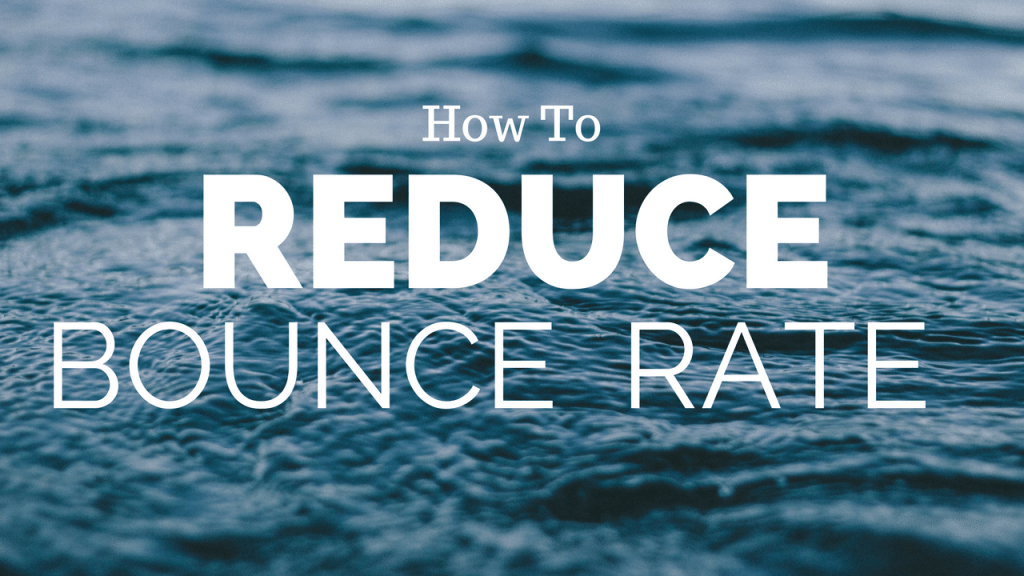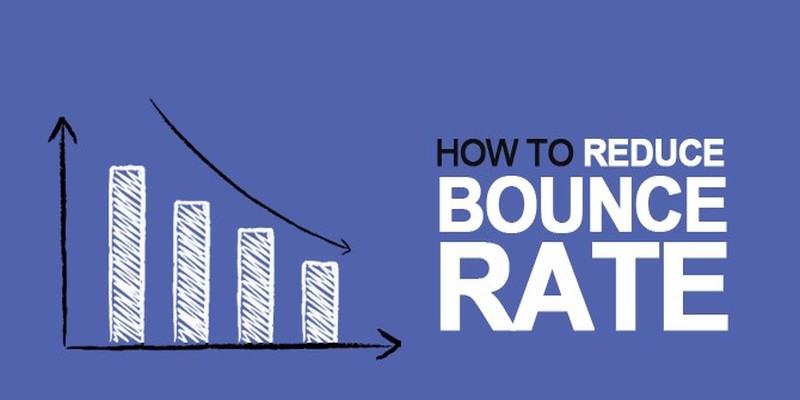The bounce rate is based on calculating the number of bounces over the total page views on a page. A bounce happens whenever a user enters the page and consequently exits without visiting another page on the website, or interacting with any of the elements on the page (e.g. clicking on links, buttons or commenting).

These tips will help you decrease bounce rates for your site
Speed is King
A website that loads at a lethargic pace is what one calls a bounce paradise. For every extra second your web pages take to load, your conversions can drop.
Decibel Insight’s research on page load time and bounce rate says that slow loaders have a 72% higher bounce rate than fast loaders, and a 38% higher bounce rate than medium loaders. A fast-loading site also scores high on search rankings. Site speed is critical and you should take all possible steps to make yours faster. Here’s a link to Google’s best practices to reduce loading time.
Pay Attention to the Size of Search Bar
One reason for high eCommerce bounce rate is that visitors are not able to find what they are looking for. To combat this problem, you have to make your search bar as prominent as possible. According to a Jakob Nielsen report, an ideal search box should be 27-character wide (this research is from 2002). However, search bars on average are only 18-character-wide. Though you can type long queries in short boxes, the problem is that only a portion of the query will be visible at a time. This makes editing or reviewing the query difficult.
If you can’t devote so much prime real estate to your search bar, you can try making it dynamic like AllRecipes.com. The search box automatically becomes bigger as one starts typing in the box. Another way to optimize your search bar is to make it persistent (or ‘sticky’) like Shopstyle UK. Fix it at the top of the page so that visitors who scroll down the page never lose sight of it.
Split Test the Timing of Your Modal Box
Imagine you have just entered an apparel store. You are walking at your own unhurried pace when suddenly a burly man runs into you with a feedback form. He asks you what did you like in the store, what would make you come back, would you recommend the store to a friend, or would you like to receive their yearly membership card? How would you react? If you possess infinite patience, you might just politely ask him to give you some breathing space — but not before mentally pledging not to enter the store again!
Now think of online shopping and modal boxes. Those theatrical pop-ups are a lot like that burly salesman. However, I won’t completely disregard modal boxes. They can be extremely useful in increasing conversions. The key lies in figuring out how long you should wait before making them pop open. If they pop-up too early, you risk strangling the visitor. Time it for a little too late, and the visitor is already off to another tab. Solution? A/B test the popup timing.
Have a Strong Site-Search Solution
Having an ideal-length search box will not be enough if it doesn’t show up the right results. If you’ve never really considered how site-search might be affecting your site experience, then now is the time to do it.
Offer a Live Chat Help
While enhanced product findability and an exhaustive help section will resolve a lot of customer queries, having a 24-hour live chat feature is even a bigger boost. Visitors might get stuck at places you didn’t take into account or they might have questions you never thought existed.
Installing a live chat widget can go a long way in taking care of bounce. A well-trained customer executive not only resolves the query of the prospect but engages them till they get convinced about making the purchase. There are a few smart chat widgets which intuitively pop open when they figure out that a customer might be lost — depending on how they are behaving on a page. The next 3 best practices are specifically for product pages:
Display the Top Deals/Discounts/Limited Time Offers
Play the urgency card to get the visitors hooked. Scarcity has been identified as one of the six persuasion principles by Robert Cialdini in his epic book on influence. One way to engage visitors on the homepage is by displaying your best deals and discounts in the banner itself. See how eBags prominently displays its limited time offer in the top banner.
Limited-time discounts catch eyeballs and you will be doing yourself a great injustice if you don’t utilize them to hook the visitors.
Eliminate Distractions
Too many choices often confuse people and impair action. Let there be no bombardment of information on your homepage. Simplify your design and work towards reducing distractions. Inside Buzz, a VWO customer, used A/B testing to create a homepage with reduced options. The simplified version increased site engagement by 17.8%.
Give them the Option to Engage Further
It might be the case that the prospect is not yet ready to make a purchase and needs more convincing. In that case, having just a prominent CTA on the product page won’t make the cut. You have to feed him/her with extra information by providing links to product manuals, guides and customer reviews. But make sure there’s a ‘Buy Now’ CTA on all these new links you are making them open. The idea is to keep the visitor on the site long enough to make the sale.
Invest in a Responsive Design
Your visitors will be accessing your site either from a laptop, tablet, smartphone or sometimes use all three devices at different stages of the funnel. Responsive web design provides an optimal viewing experience across different browsers and devices. It ensures the layout is resized in a way that the text and images don’t break.

In Sum:
The 7 ways to reduce your bounce rate
First of all, you need to give your visitors a reason to stay; revisit your conversion funnel. Don’t just assume that the website has navigation issues or a faulty site design.
- Focus on high traffic landing pages from high conversion sources.
- Test your efforts, like, the channels you are active on, the types of landing pages, your CTA’s and so on.
- Integrate keywords to your copy, that your core audience enters into search engines to ensure high quality traffic. Don’t forget to carefully write your meta-descriptions, these texts are the first thing people will see in their search results before they click on your page.
- Target your ads wisely, consider who your audience is and what channels you will use.
- Check your Site Speed, if your website loads too slow users (especially mobile users) will give up – after about 3 seconds -.
- Shorten your landing page copy, don’t use large bodies of text. These can be difficult to read, visitors have limited patience.
- Step away from distracting content that can cause early exits, like music, video, and intrusive pop-ups.
Bounce rate on 2 levels
A bounce rate can be calculated on 2 levels within Google Analytics. GA calculates the bounce rate for a single web page and the bounce rate of your entire website.
The bounce rate of a single web page is the absolute number of bounces, or single page visits, on a page (in a given time period) / total number of entries on that page (in the same time period).
The bounce rate of the total website is total number of bounces across all pages on the site (in a given time period) / total number of entrances across all pages on the website (in the same time period).
____________________________________________________________________________________________
We provide the best quality backlinks as ever, pls contact us qualitybacklink.net@gmail.com ; Skype: qualitybacklink






